CBSE Previous Year Question Papers Class 12 Physical Education 2018 Delhi
Time allowed : 3 hours
Maximum marks: 70
General Instructions:
- The question paper contains 26 questions.
- All questions are compulsory.
- Question no. 1 to 11 carry 1 mark each. Answers to these questions should be in approximately 10-20 words each.
- Questions no. 12 to 19 carry 3 marks each. Answers to these questions should be in approximately 30-50 words each.
- Questions no. 20 to 26 carry 5 marks each. Answers to these questions should be in approximately 75-100 words each.
** Answer is not given due to change in the present syllabus
Question 1.
What do you mean by ‘Fixture’ ? [1]
Answer:
The organized method in which teams participate in any tournament is a fixture.
Question 2.
Why does the weightlifter’s diet include lots of proteins? [1]
Answer:
Since weightlifter has to build muscles to keep them energetic they take high-protein diet. Protein is important for muscle growth and to repair body tissues. Protein is also used by the body for energy.
Question 3.
What is Hypertension ? [1]
Answer:
Hypertension means the increased blood pressure. It may eventually cause health problems such as heart diseases.
Question 4.
What do you understand by ‘Physical Disability’ ? [1]
Answer:
Physical disability : It is a limitation on individual’s physical functioning, mobility, dexterity or stamina. Physical disability may either be motor deficiency or sensory impairment.
Question 5.
What is the main cause of ‘Scoliosis’ ? [1]
Answer:
Main cause of Scoliosis are :
- Injury of the bones and Joints
- Faulty posture
Question 6.
What is ‘Amenorrhoea’ in female athletes triad ? [1]
Answer:
Amenorrhoea : It is the absence of menses for 6 months or absence of menstrual cycle for the three cycles.
Question 7.
What do you know about the term ‘Cardiac Output’ ? [1]
Answer:
Cardiac output is the amount of blood pumped by the heart in 1 minute. This increases exercise intensity.
Question 8.
What type of fracture is known as Greenstick Fracture ? [1]
Answer:
Greenstick is a fracture in a young, soft bone. In green stick, the bone bends and breaks. This fracture is very difficult to detect and is usu¬ally found in children.
Question 9.
What do you mean by ‘Kinesiology’ ? [1]
Answer:
Kinesiology is the branch of physiology that studies mechanics and anatomy in relation to movement.
Question 10.
Define the term “Emotions’. [1]
Answer:
Emotions are feelings which result in physical and psychological changes that influence the behaviour of and individual.
Question 11.
Explain the term “Sports Training”. [1]
Answer:
Sports Training : Sports training is a specialised process of all round physical conditioning aimed at the preparation of sports-person for improving its performance in games and sports.
Question 12.
Naman was a Class VI student. He used to bring junk-food in his lunch-box daily. His teacher observed that he was neither concentrating on his studies nor actively participating in physical activities. In this matter, he had a talk with his parents and came to know that he refuses to eat roti, dal, fruits and vegetables. Due to this he is facing these problems.
Based on the above passage, answer the following questions :
(a) What types of problems was Naman facing?
(b) Why should junk-food not be recommended ?
(c) What values has his teacher shown in this matter ?** [3]
Answer:
(a) Naman had problem with proper balanced diet. He was eating junk food instead of roti, dal, fruits and vegetables.
(b) Junk food contains only fat and leads to obesity. Also junk food does not have protein,
vitamin required for athletes, hence it is not recommended.
Question 13.
Write briefly about some considerations of fluid intake pre, during and post competition, that affect the sportsperson’s performance.** [3]
Question 14.
What are the benefits of physical activities for children with special needs ? Explain. [3]
Answer:
Benefits of physical activities for children with special needs are :
- Physical improvement
- Reduce risk of health complications
- Mental improvement
- Behavioral patterns
- Better emotional and psychological health,
- Reduced level of anxiety, stress and
depression : Physical activities may help in reducing the level of anxiety, stress and depression of children with special needs. - Improved social interaction : Physical activities provide ample opportunities for improving the social interaction among children with special needs. Some relations are developed during involvement in physical activities.
- Cognitive benefits : Physical activities lead to cognitive skill, improvement in children with disabilities. These activities allow them to discover and access strengths that cannot be challenged in classroom setting.
- Reduced level of anxiety, stress and
Question 15.
How does participation in Games and Sports contribute to the psychological development of women athletes in India ? Explain.** [3]
Question 16.
Write briefly about menstrual dysfunctions and their effect on sports participation of female athletes. [3]
Answer:
Menstrual dysfunction: It is a disorder or irregular menstrual cycle in woman. It can also be defined as “An abnormal bleeding during the Menstrual cycle”.
Effects on sports participation :
- During menstrual period, women athlete performance level is low. Women cannot perform so effectively.
- During the cycle of menstrual period, women feel tension, anxiousness and uncomfortable within body.
- Often at this time, women have complaints of vomiting and pain in stomach.
- During the menstrual period, woman athelete cannot take part in many competitions like, jumping, weightlifting, wrestling, boxing etc.
Question 17.
What do you understand by “First-Aid” ? How will you manage joint injuries ? Explain. [3] Answer:
First Aid : It is the immediate care given to an injured or ill person. It does not take the place of proper medical treatment. It is a temporary assistance before actual medical care is obtained.
Management of joint injuries :
- Cold compression should be used immediately. The application of ice or cold water should not be used for more than 40 minutes persistently.
- The cold compression should be performed 5 to 6 times daily.
- If there is more swelling at the sight of contusion, the anti-inflammatory medicine should be given.
- If the swelling persists, consult the doctor immediately.
- For the purpose of rehabilitation, the flexibility exercises should be performed carefully.
Question 18.
What do you understand by Sports Medicine ? Discuss briefly about the scope of Sports Medicine. [3]
Answer:
Sports Medicine : Sports medicine is a branch of healthcare. It deals with the diagnosis, treatment and prevention of injuries, related to participation in sports and/or exercises.
Scope of sports medicines : In the field of physical education and sports, the fields of various sub-disciplines of sports medicine are utilised. Without the knowledge of scope of sports medicines, it is difficult to carry a sportsperson performance at apex level. There are following scopes of sports medicine :
- Sports and first aid.
- Human anatomy and physiology.
- Female and sports.
- Study of optimal load for different age groups.
- Scientific promotion of games and sports.
- Sports injury rehabilitation.
- Fitness for games and sports.
Aims of sports medicines
- To provide information to athletes about injuries.
- To provide knowledge about the causes of injuries.
- To provide means or treatment for sports injuries and for rehabilitation of injuries.
- To provide knowledge about the preventive measures of sports injuries.
- To aware the sportsperson and athletes about the different kinds of injuries in respect of different games.
- To concentrate on the cause of injury.
Question 19.
What are the factors affecting Self-Esteem and Body Image ? Explain.** [3]
Question 20.
Mention all calculations and steps involved to draw a Knock-out fixture of 19 teams, where 4 teams are to be seeded. [5]
Answer:
Knock-out tournaments : In knock-out tournaments, the teams which get eliminated get out automatically from the tournament. Only the winners continue in the competition. It is the fastest method to know about the winner team in the tournament.
Seeding a Team : The sorting of the teams and fitting them in the fixtures , so that the stronger teams do not meet each other in earlier rounds is known as seedings.
Advantages of knock-out tournament:
- These are less expensive.
- Helpful in enhancing standard of sports.
- It requires less time to complete the tournament.
- Minimum number of officials are required. Total number of rounds played in tournament depends upon number of teams participating in tournament.
Drawing a Knock-out fixtures of 19 Teams :
Number of Teams—19
Total number of Matches = N-1 = 19-1 = 18
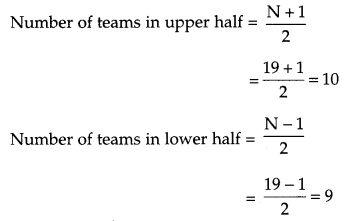
(i) Number of upper half is divided in two parts Q1 and Q2 with 5 teams each.
(ii) Number of lower half is divided in two parts Q3 and Q4 with 5 and 4 teams respectively.
(iii) Number of Byes in Quarter where 5 Teams

(iv) Number of Byes in Quarter where 4 Teams participating (in present case)—All 4 Teams
(v) In such scenario, the match shall be as per the following:
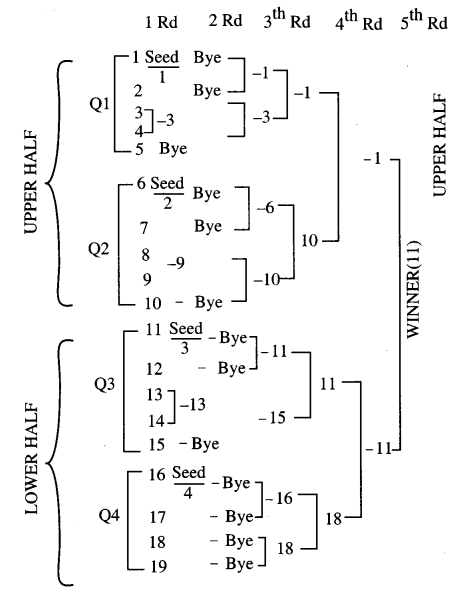
As per above distribution, the groups can be formulated in a way that any team gets only one Bye (maximum).
Question 21.
Briefly explain the symptoms and causes of Asthma. Explain the procedure, benefits and contra-indications of any two asanas to prevent Asthma. [5]
Answer:
Asthma : Asthma disease is associated with the swelling of respiratory tracts which makes the tracts very sensitive and makes this process pungent with the touch of any effective things. These reactions cause contractions in the tubes, this reduces the amount of air in the lungs due to which it becomes difficult to breathe. Common symptoms of asthma are coughing, . heavy breathing, chest tightness, fatigue, pain in hands, feet, shoulder and back. Reasons are dust, smoke pollen grains, animal skin, hair and feather etc.
Asthma can be controlled by Matsyasana, Go-mukh-asana etc.
Matsyasana : This asana is performed in water body, hence it is called as Matsyasana.
Pre-Stage : Sit in Padmasana pose.
Method :
(i) Take support of your elbow and lie on your back, bend your neck with support of your hands and try to touch your head to the ground.
(ii) Hold toes of the feet firmly with both hands and touch ground with the elbows.
(iii) Stretch the stomach as up as possible. Benefits : This asana is very useful for asthama patient, it provide relief from indigestion and other digestive problems, keeps the blood clean. Helps in cough and respiratory problems. It makes body and face attractive by bringing natural glow on it.
Contra-indications :
- Abnormal blood pressure : Individuals suffering from high or low blood pressure should avoid this posture.
- Neck injury : Neck injuries or any part of the lower back or middle back can make it difficult to practice this Fish pose and hence should be avoided.
Gomukhasana: This asana gets its name because while doing this asana, body resembles a cow face pose.
Pre-stage : Sit in Sukhasana pose.
Method:
- Sit in sukhasana pose.
- Place the ankle of left leg near the right butt.
- Place the right leg over the left thigh, so that knees should place over each other.
- Sweep your left hand behind your back, fac¬ing palms upwards.
- Now interlock fingers of both hands behind your back.
- Stretch both the hands in their respective direction, look straight.
- Repeat with changing leg position.
Benefits : Helps in curing Asthma, reduces weight, makes body flexible.
Contra-indications :
-
- People with very stiff shoulder may have to take it slow and easy.
- If you have sciatica, then crossing the knee may not too good as there will be pressure at the sciatic nerve.
Question 22.
What are the types of motor development ? Describe any six factors affecting motor development in children. [5]
Answer:
Motor Development : It refers to the development of general body control, fine motor skills and large muscle movements. There are three stages of motor development in children- infancy or infancyhood, early childhood and later childhood.
It is of two types :
- Gross Motor development : It involves the development of large muscles in the child’s body such as sitting, walking, running etc.
- Fine Motor development : It involves the development of small muscles of the body, especially during the small movements of the fingers and hands, Example : holding of Javelin, discus and pole, catching a cricket ball etc.
Factors affecting Motor Developments :
(i) Nutrition : Nutritious food promotes good motor development. Sensory motor development is dependent upon nutrition that the child gets to a good extent. Children get stronger if they get nutritious food.
(ii) Immunisation : If mother and child both are immunised at proper time, it leads to a good sensory motor development.
(iii) Environment : Encouragement, love and security help the child to take risk to explore fearlessly and to know more about environment which leads to a better sensory development. Some of other factors affecting Motor development :
- Sleep
- Stimulation and interaction
- Opportunities
- Training and practice
- Recreation
- Education : Learning and productivity
- Gender
- Posture deformities
- Sensory impairment
- Obesity
- Social skills
- Mental health.
Question 23.
Write in detail about ‘Barrow’s Motor Ability Test’ to measure motor fitness components. [5] Answer:
General Motor Fitness : Barrow’s Motor Ability test—This test is performed (Standing Broad Jump, Zig Zag Run and Medicine Ball put). The test battery comprised of three items which are explained below :
(i) Standing broad Jump : To measure not only power but also agility, speed and strength. Equipment and facilities required : One 5 × 12 feet mat marked with take off line and parallel lines 2 inches apart.
Directions : The subject is advised to stand just behind the take off line with feet together. Then by giving swing of arms and bending knees, a jump is taken, the arms are swung. Three trials are given.
Scoring : The final score is the distance covered in inches from the best jump.
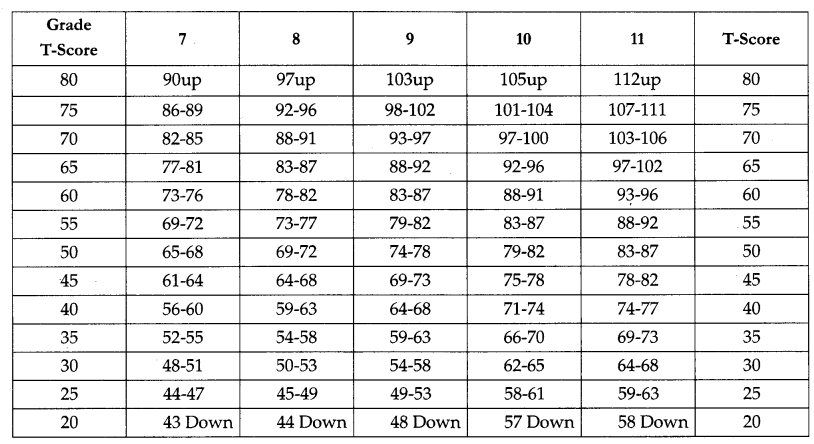
(ii) ZigZag Run:
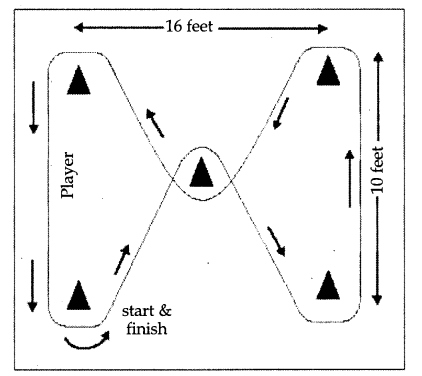
Purpose : To measure mainly agility, but speed as well.
Facilities and Equipment: One stop watch and 5 flags or cones as shown in diagram.
Direction : First of all a demonstration is given. The subject is advised to stand just behind the starting line. Then, running in a zig-zag manner, three rounds are completed.
Instructions : The subject can start from standing position. After the start, running is done in a manner of figure of eight. Like this, three circuits are completed.
Scoring : The final score is the time in seconds for three laps.
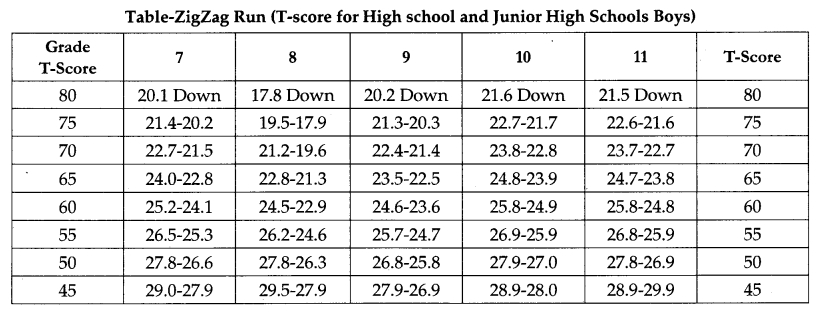

(iii) Six Pound Medicine Ball Put:
Purpose of the Test: To measure mainly strength of arms and shoulder girdle but also to measure degree of arm and shoulder co-ordination, speed and balance.
Facilities and Equipment required : A space in the gymnasium hall with 90 feet × 25 feet dimensions available for use. A 15 feet restraining line marked. One medicine ball weighing six pounds and one measuring tape.
Directions : First of all the event is explained and a demonstration is given. The subject is advised to put the ball but “no throwing” is not allowed. Three trials are given, but if the subject commits three faults, then he must try until he makes a fair put.
Instructions : The subject must take the position before the restraining line. No over stepping is allowed over the restraining line. The medicine ball is put, not thrown.
Scoring: The final score is the distance of the best put in feet.
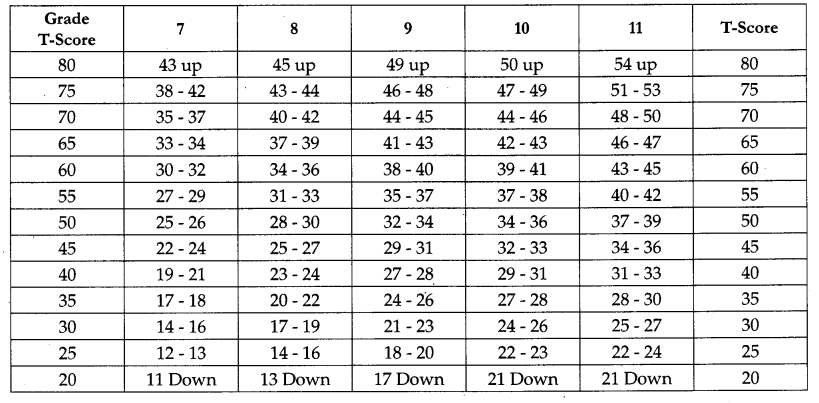
Question 24.
Write in detail about the physiological changes taking place due to ageing. [5]
Answer:
The physiological changes, due to ageing, which take place are mentioned herein :
(i) Changes in Nervous System : The reaction time and movement time slow down with increase of age. The brain waits, the size of its network and its blood flow decreases with age.
(ii) Change in Gastrointestinal System: With an increase in age, there is a reduction in the production of Hydrochloric acid, digestive enzymes and saliva. These changes may result in delayed emptying of the stomach, impaired swallowing. The breakdown and absorption of food may also be impaired. The liver becomes less efficient in metabolising drugs and repairing damages liver cells.
(iii) Changes in Urinal system: With an increas¬ing age the mass of the kidney decreases, which leads to reduction in blood filtration by the kidneys. The capacity of the bladders decreases and there is an increase in residual urine. This
increases the chance of urinal infections.
(iv) Changes in Senses : With an advance in age, the senses such as vision, hearing, taste, smell and touch may become less active. Vision and hearing are affected the most by ageing. The taste buds are reduced with age. So, they loose interest in food.
(v) Change in Respiratory System : Pulmonary function is impaired with advancing age. The airways and lung tissues become less elastic and less efficient. There is decrease in the oxygen uptake and oxygen exchange.
(vi) Change in Fitness : The elasticity of tendons, ligaments and joint capsules decrease with ageing. The range of the movements is restricted and muscle mass decreases as the age increases. This leads a decrease in flexibility, endurance, strength and speed along with a shortness of breath, blood flow, enzymes etc.
Question 25.
Mention in detail about the Aerodynamic Principles and also discuss about the application of aerodynamics in sports.** [5]
Question 26.
What do you understand by High Altitude Training in sports ? What is the impact of high altitude training on athletes ? Write in detail.**